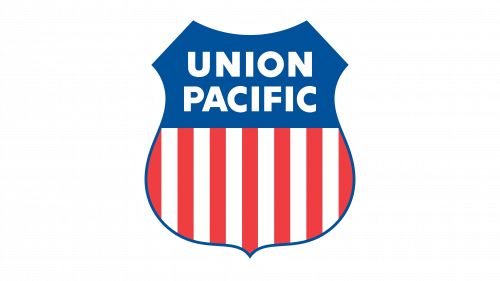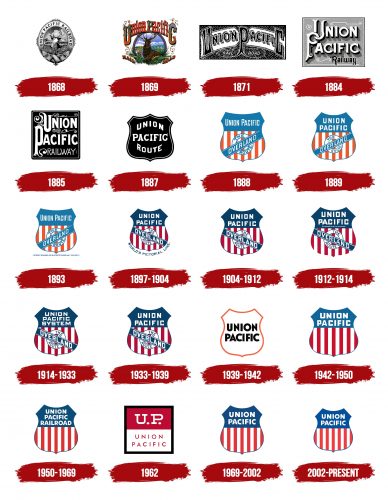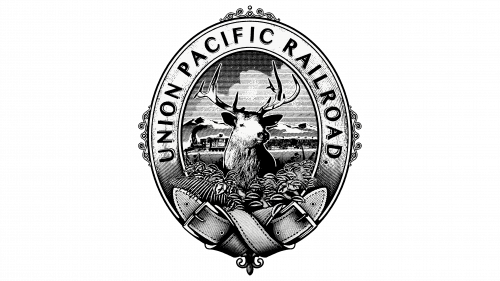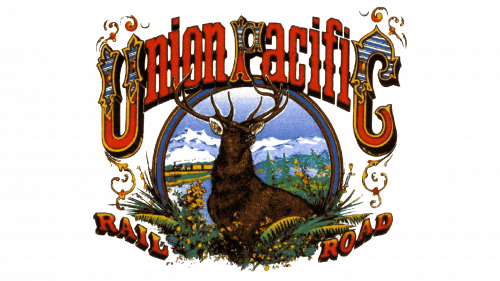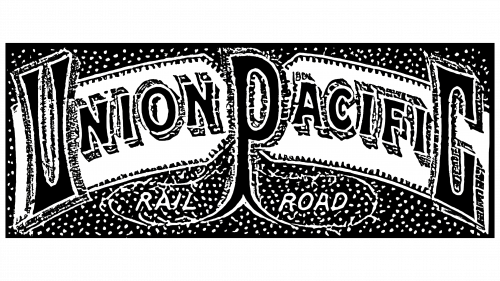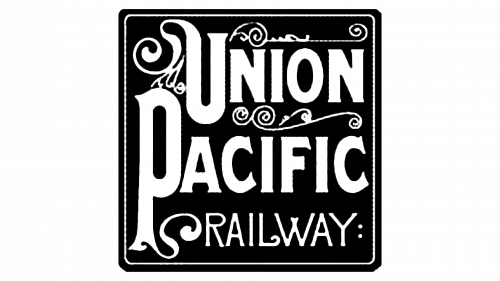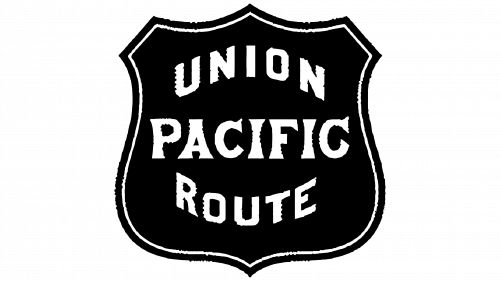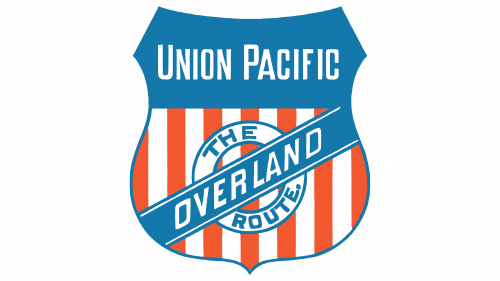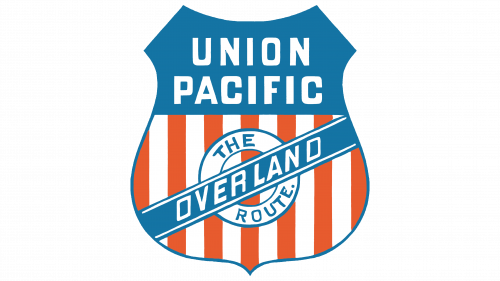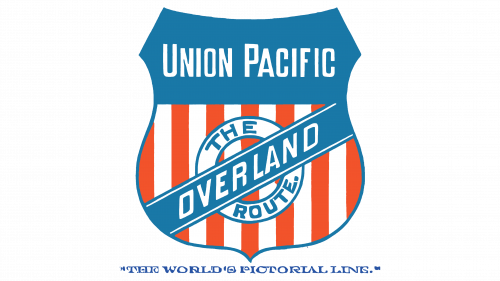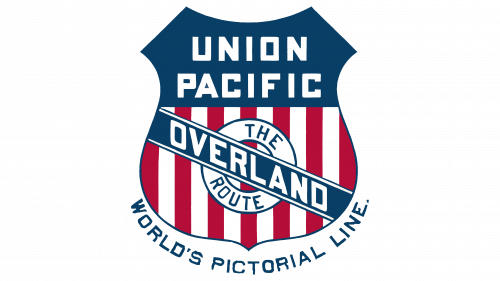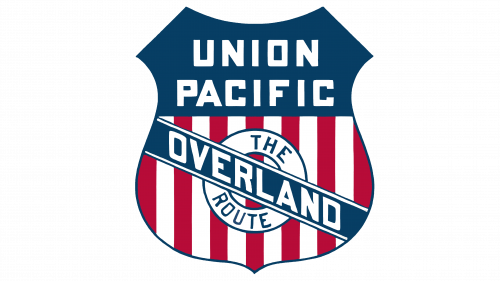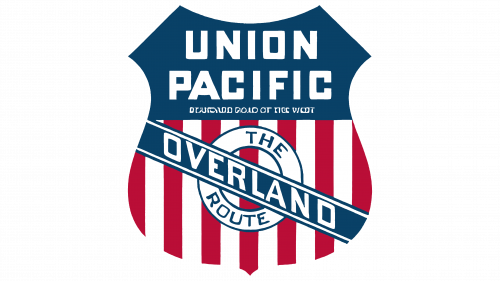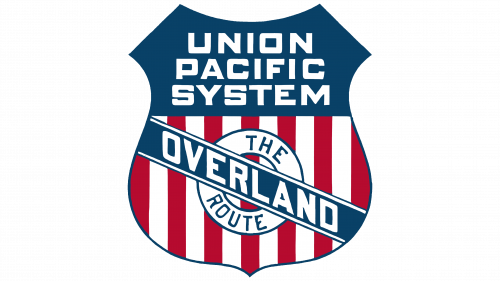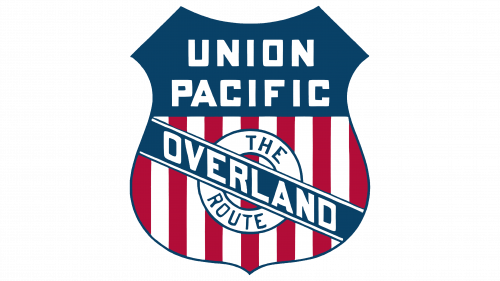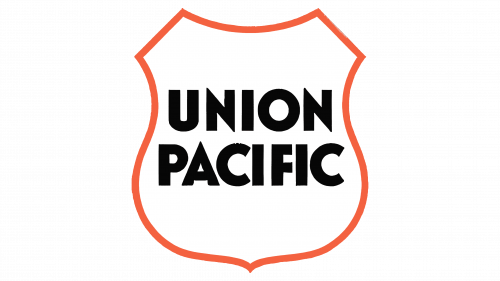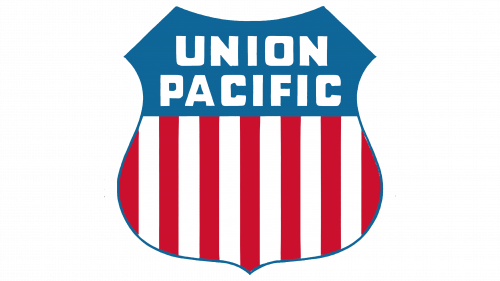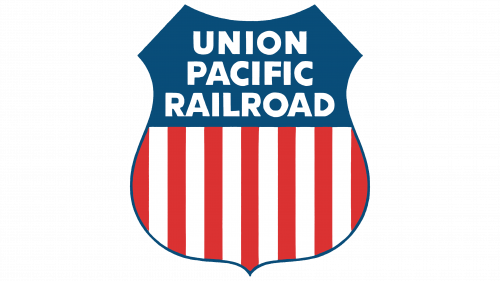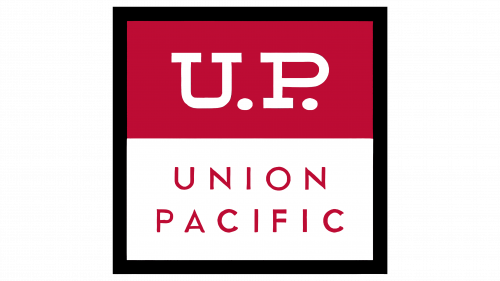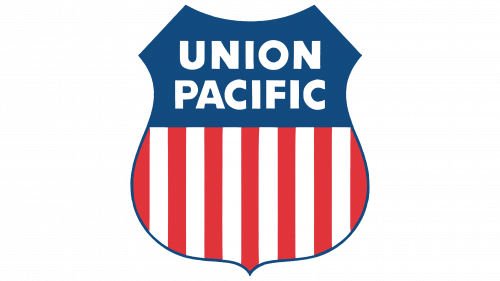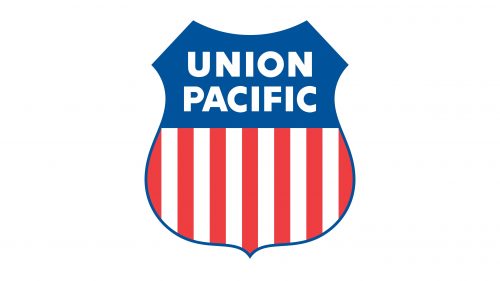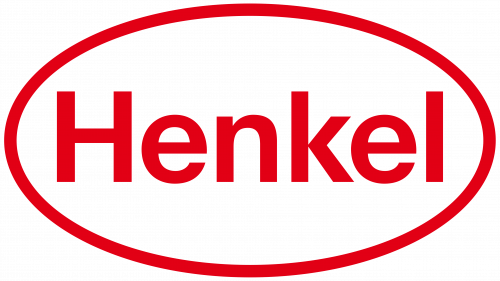The Union Pacific logo is a visual representation of great strength and a close connection with America. It embodies the unbreakable spirit that helped the company link all corners of the vast continent with railroad arteries. The emblem reflects a serious approach to business and a high level of responsibility for passengers and cargo.
Union Pacific: Brand overview
The Pacific Railway Act was passed into law by US President Abraham Lincoln in 1862, marking the beginning of Union Pacific’s history. This act approved the construction of the transcontinental railroad linking the east and west coasts of the United States. The Union Pacific Railroad Company was established in Omaha, Nebraska, on July 1, 1862, to build this railroad’s western segment.
One of the biggest technical undertakings of its era, the railroad’s construction got underway in 1865. Workers at the company, many immigrants from China and Ireland, had to deal with severe weather and terrain.
The “Golden Spike” ceremony’s driving, which marked the Union Pacific Railroad’s union with the Central Pacific Railroad, occurred on May 10, 1869, at Promontory, Utah. On this occasion, the United States’ first transcontinental railroad was completed.
The firm grew its railroad network by purchasing and constructing new lines during the following decades. The business made significant contributions to economic expansion and the settlement of new areas during the development of the American West.
Financial issues beset the enterprise around the turn of the 20th century. Despite filing for bankruptcy in 1893, the business could restructure and continue as usual. Financial tycoon Edward Henry Harriman oversaw the enterprise during this time, and he modernized the train infrastructure significantly.
The company underwent more modernization and expansion in the first part of the 20th century. The firm actively contributed to supplying the nation’s transportation needs throughout World Wars.
During the 1950s and 60s, the growth of air travel and automobiles presented new difficulties for the American railroad sector. As a result, the business started to broaden its operations.
The creation of Union Pacific Corporation in 1969 as a holding company for Union Pacific Railroad and other acquired companies marked a significant turning point in the corporation’s history. This move allowed the business to diversify outside rail transportation.
Several mergers and acquisitions characterized the 1970s and 1980s. In 1980, the company greatly increased the size of its train network when it purchased the Western Pacific train and the Missouri Pacific Railroad.
The U.S. railroad business saw greater consolidation during the 1990s. The enterprise bought the Southern Pacific Rail Corporation in 1996 after purchasing the Chicago and North Western Transportation Company in 1995. As a result of these purchases, it is now the biggest railroad in the US.
The business concentrated on increasing operational efficiency at the beginning of the 2000s. The firm made large investments in the adoption of new technology and the upgrade of its infrastructure.
2008 saw the completion of a significant project: replacing the antiquated 1906 bridge over the Mississippi River in Iowa with a new structure.
In the 2010s, the company invested in advancing intermodal transportation and continued updating its locomotives and railcars fleet.
In 2018, it introduced Unified Plan 2020, a new operational model designed to increase productivity and boost customer satisfaction.
The firm kept up its modernization and efficiency-boosting plan in 2021. The business made a large financial investment to modernize its fleet of locomotives by purchasing brand-new, extremely effective locomotives with improved environmental features. These locomotives were fitted with cutting-edge control technologies that minimized harmful emissions and maximized fuel efficiency.
In 2022, the enterprise significantly advanced toward automating its rail operations. The business started extensively deploying Positive Train Control (PTC) technology throughout its network. PTC is an automatic train control system that raises operational effectiveness and safety standards. One of the biggest technology initiatives in the company’s history was born out of this endeavor.
In 2023, the firm made notable strides toward sustainability. The business unveiled a bold strategy to cut carbon dioxide emissions from 2018 by 26% by 2030. The company started testing locomotives driven by alternative fuels, such as hydrogen and biofuel, to accomplish this goal.
In 2024, its multimodal transportation services grew. To improve connections between rail and truck transport, the company built numerous new intermodal terminals in important transportation hubs throughout the United States. The timely and effective container transfers made possible by these terminals’ state-of-the-art equipment greatly shortened the time it took to deliver cargo.
In the same year, the firm continued improving its digital infrastructure. The business upgraded its logistics management system using artificial intelligence, enhancing transportation planning and optimizing rail routes. This technology analyzes large amounts of data in real-time, helping with more efficient decision-making regarding resource allocation and train movement.
The company keeps expanding and changing to meet the changing needs of the freight transportation industry.
Meaning and History
What is Union Pacific?
It is a major American railroad company that operates the largest railroad network in the United States. It plays a critical role in transporting goods and commodities across the country, providing freight rail services that connect major markets in the West, Midwest, and Gulf Coast. The company covers more than 32,000 miles and serves a variety of industries, including agriculture, automotive, chemical, coal, consumer products, and intermodal transportation. It is known for rail transportation security, making it a key player in the U.S. logistics and supply chain industry.
1868
The deer is a symbol of pride for America and one of its emblems because it inhabits both continents, even controlling untamed lands. It is found everywhere—from the pampas to the highlands—paving its way with its powerful body. This means it is a strong animal, comparable to a locomotive. Additionally, it is resilient, with excellent adaptability to forested, mountainous, marshy, and any other terrain, pioneering new territories. For this reason, its image was used in the first logos of the railroad company.
Moreover, it is a noble symbol: the deer is always majestic, calm, confident, wise, and proud. It is associated with light, renewal, creation, rebirth, and spirituality, as its antlers resemble the sun’s rays in mythology. From a folklore perspective, it is considered a positive totem. It fits perfectly into the state’s world order, representing one of the most challenging industries associated with draft power, high speed, and long-lasting endurance.
Therefore, the central figure in the Union Pacific emblem is a composite image of all types of American deer. By doing this, the corporation shows a strong connection with America, emphasizes its authenticity, and conveys that it can reach any corner of the continent. The deer, with its beautiful, branching antlers, occupies the central part of the medallion, symbolizing the extensive railway network. Its pose exudes tremendous strength, and its gaze reflects self-confidence. The animal looks straight ahead, holding its head high. Its powerful torso is hidden behind tall grass, but you can still sense the creature’s physical strength.
In the background, a train is shown: the locomotive relentlessly pulls a string of cars, demonstrating its power and the remarkable beauty of uncharted lands. It takes pride in every corner of the country it travels through. The train moves against the backdrop of high mountains with snow-capped peaks, and above them, large fluffy clouds race by, hinting at the comfortable conditions in the train cars. Below the deer, two strong straps are depicted and connected, symbolizing the reliability of the railway junctions.
A company name inscription in a smooth, sans-serif font surrounds the vertical oval of the logo. The bold letters are spaced apart, making the inscription highly legible. The wide intra-letter spacing also contributes to the excellent readability of the text. Moreover, the glyphs have shadows that give them depth. The three-dimensional letters appear intriguing and draw attention, keeping the focus on the brand name.
On the edge of the frame, you can also notice small ornate patterns in a retro style. They represent the time of the company’s founding—the mid-19th century, an era of monograms and medallions. It’s no coincidence that the emblem has this particular shape—an oval, elongated vertically, in the form of a cameo. This signifies that the logo has a clear concept and a solid connection to the railroad carrier.
1869
Monochrome gave way to color, so the Union Pacific logo is multi-colored. The artists worked to preserve the accuracy of the colors, so the sky is blue, the snow on the mountain peaks is white, and the deer is dark brown. The train is also painted: black smoke billows from its stack as it pulls yellow cars. There’s now a lot of greenery (grass, trees, ferns) and bright forest flowers. All the elements are compactly arranged in a small space, so the emblem resembles a painting more than an official visual identity object.
The logo drastically changed its shape: now it consists of a single circle with drawn elements and two inscriptions – one at the top and one at the bottom. They contain the main information:
- The company name (Union Pacific);
- A clarification of its activity (Rail Road).
Both inscriptions are slightly curved and designed in a retro style. In the first line, the letters are mostly lowercase, except for three: “U,” “P,” and “C.” These are much larger than the rest because they begin and end the phrase. The designers used them to frame the words, creating them as initials – beautifully adorned glyphs with intricate filigree ornaments and geometric patterns matching the theme.
In this case, these symbols are presented in Old English style, complemented by teardrop-shaped plant elements, and painted with blue, white, and red stripes to match the American flag. The letters between them are much simpler in style – they have straight edges, a geometric shape, and no sharp points, so they look like carved figures. A solid ridge connects them in the middle, making the inscription cohesive. The glyphs are colored red – a symbol of leadership and high energy.
The words in the second line are arranged diagonally, with the outer ends tilted upward. They are set in an extra-bold serif typeface with massive serifs and shadows, giving the inscriptions a 3D effect and making the letters appear volumetric. The words “Rail” and “Road” point in opposite directions, fitting perfectly into the composition of fern leaves parted by the powerful body of the deer. The animal is depicted standing in the circle’s center with a double frame. The deer holds its head high with large, branching antlers and gazes attentively into the distance to explore new territories.
1871
After the transition to TA Scott, Union Pacific’s visual identity underwent a drastic change. The new owner abandoned the logo featuring a deer and a train against a mountain landscape. Romance, creativity, allusions, and a connection to authenticity were left behind. In their place came strictness, a business-like style, utilitarianism, and spectacle. So, what exactly changed?
- The emblem became classically rectangular. The horizontal geometric figure serves as the base for various graphic elements and inscriptions, which stand out in contrast against its background.
- The logo’s content lost realism and was replaced by abstraction. Landscapes disappeared—only a stylized inscription of an unusual design remained, filling the entire inner space.
- The Old English-style letters were left behind: tall glyphs with narrow middles and widened ends appeared. Simple sans-serif symbols, thin and slanted, were used for the second line.
- The retro style is gone, giving way to futurism, because the logo’s image is barely discernible, even in simple monochrome. At the same time, there is a lot of visual noise in the form of small white dots on a black background.
- Color also disappeared: the emblem became black and white. The background is dark, while all elements on it are light. The strips with the company name are colored white, which slightly lightens the otherwise oppressive atmosphere.
At the same time, the Union Pacific logo gained a lot of dynamism. For example, this is well demonstrated in the slanted glyphs, long winding lines, the arched inscription, the alternation of narrow and wide strokes, and the visual flickering of chaotic white dots that resemble falling snow.
Even though all the letters are now uppercase, the designers kept “U,” “P,” and “C” as the accent letters. They emphasized them by making them twice as large as the other symbols. As a result, the central glyph resembles a tree with roots, within which the second line is hidden – with the words “Rail” (on the left) and “Road” (on the right).
The company name is decorated with ornamental elements, so the characters look like Old English letters. This adds a touch of nobility to the emblem, which was lost along with the image of the deer. Additionally, the glyphs were given wide-hatched shadows, turning them into three-dimensional objects.
1884
This Union Pacific logo is the most welcoming of all. It concentrates positive energy, calm light, confidence, and softness. This impression is created by a harmoniously chosen palette dominated by a pleasant gray shade. Many new features have appeared, ranging from the color to the composition.
The emblem now has a square shape with three-dimensional elements. The geometric figure is perfectly even, forming a clear internal space. It has a double black-and-white frame that evenly surrounds the square along the entire perimeter to demonstrate excellent conditions for transporting passengers and cargo and the technical safety of train operations and their security. This border perfectly isolates everything inside from external factors.
The core of the emblem is the name, which is evenly distributed across the logo, occupying the entire area. The inscription is placed in two rows, centered. The initial letters (“U” and “P”) are intertwined and resemble a monogram. However, they are not perceived as ancient symbols, resembling hand tools or keys in a link. But there is still a mix of styles, hinted at by the abundance of flourishes—curls and twisted thin lines. They suggest that the emblem has a retro style, while its clear arrangement and strict geometry indicate the presence of an industrial style.
At that time, the company was going through a transitional period, balancing old and new views in its work and identity, experimenting with options, and choosing the most suitable one. This thought is prompted by the logo, which looks like a technical diagram or a circuit board, where the medieval flourishes are perceived as modern spirals.
The font chosen for the remaining letters (“nion” and “acific”) looks progressive. It includes extra-bold outline glyphs with shadows and small sharp serifs. As a result, the text became massive and now occupies almost all the internal space, and the presence of shadows makes it three-dimensional. Another inscription appeared at the bottom—black and barely noticeable. The word “Railway” is written in bold glyphs with flourishes, clarifying the company’s field of activity. The “R” and “y” curved ends resemble heraldic elements.
The background for the text is a light gray plate, as if covered with embossing because the previously unclear flakes of white “snow” have now turned into a harmonious roughness of the metal surface. The monochrome letters stand out clearly among the flourishes thanks to additional shadows painted in dark gray.
1885
The Union Pacific logo of this era is characterized by its massiveness. Despite having the same details, it is a weighted version of the previous emblem. However, it is smaller because it is a perfectly square shape containing graphic and text elements. The symbol’s style has also changed: it shifted from industrial to antique.
The logo includes a few graphic elements, including spirals and curls forming retro monograms that now appear everywhere. They separate the lines and decorate the initials (capital letters at the beginning of words). Thanks to these, the “U” and “P” appear elegant but outdated, resembling ornate glyphs from ancient books. The upper left edge of the “U” is elongated and curved, while the right lower part of the “P” stem winds.
More curls are located between the inscriptions. The word “Union” is particularly highlighted, set apart at the top and bottom by nearly identical monograms. Below the second line is the word “Railway,” modestly tucked in, set in thin, grotesque font. Despite the narrow letters, it is also styled retro, with a rounded end on the “L” and crossed strokes on the “W.” A barely noticeable border frames the entire text section.
Overall, the emblem looks like a title card for silent films, as it precisely mimics their design with monograms and ornaments. Its resemblance is enhanced by the monochrome palette, as there are only two colors in this version: white (used for the inscriptions and decorations) and black (serving as the background). This contrast ensures good readability of the text but diminishes the emblem’s design significance, which, in essence, conveys neither the company’s field of activity nor its authenticity nor its concept. Furthermore, the curls do not pair well with the heavy letters and do nothing to lighten them.
1887
This is a significant period in the history of the Union Pacific logo, as it marked the beginning of the “railroad chevron” era. Its foundation is a heraldic shield with six sharp points and two rounded edges at the bottom. In appearance, it resembles the standard badge of American police officers: it has a similar structure and inscription in the middle. From then on, the emblem remained mostly the same for a long period, with only color, size, or text changes.
The railroad company successfully redesigned, as the regular logo became an individual mark for employees. Among its distinctive features:
- Monochrome (the restrained palette emphasizes the seriousness of the brand);
- Double border (black and white lines effectively highlight the center);
- Combination of fonts (different typefaces attract more attention);
- Uppercase (capital letters are visible and easy to read).
The emblem’s design is simple: flourishes and spirals, which interfered with the perception of the text, were removed. Now, all the inner space is dedicated to inscriptions. In the center is the word “Pacific,” set in an antique-style font. It is the focal point – the largest and slightly ornate, as the letters have both narrow and wide parts, which add dynamism to the visual identity.
The upper and lower lines are curved and mirror each other, so it appears they half-surround the center from either side. Both words are in a geometric sans-serif font. The glyphs are bold, with smooth edges and straight cuts at the ends of the strokes, reinforcing a professional and strict atmosphere. The black background with white lettering further supports this.
1888
The logo was redesigned to add authenticity and emphasize the company’s connection with the country in which it operates. As a result, it became distinctive, bright, and memorable. Several key details contributed to its recognizability.
First, white and red stripes appeared alongside blue fields, like those on the USA’s national flag, but in a different shade—calm, pale, and closer to the color of the midday sky, scorched by the sun. Despite the differences in shades, these colors form a close connection with the country through which Union Pacific trains travel.
Second, the logo became even more reminiscent of a police badge. This approach to visual identity instills discipline and places the railroad company alongside important state institutions. Moreover, it looks excellent in a formal uniform, highlighting the seriousness of its services.
Third, the emblem is now divided into two zones. The brand name is displayed at the top, while the phrase “The Overland Route” is featured at the bottom, hinting at the field of activity associated with the emblem’s owner.
Fourth, a diagonal stripe and a roundel appeared, combined into a unified composition. The circle serves as a background and occupies the central part, while the wide line crosses the logo, resembling an honorary ribbon draped over the shoulder from right to left.
Through these innovations, the company underscores its significance in the country’s life, shows its origins, introduces its field of activity, and demonstrates safety and professionalism. This means that the modernized Union Pacific emblem perfectly aligns with the concept and evokes a sense of confidence, reliability, and calm.
1889
After a slight adjustment, the logo became more majestic and presentable. The changes turned it into a true “railroader’s badge” or a chevron on a uniform. The symbol gained individual features while maintaining a visual connection to the American flag, making it a recognizable global icon.
The most significant change affected the shape: now, the lower part of the Union Pacific emblem is larger than the upper part. It resembles a swollen sphere with a pointed bottom. However, the top half (with the blue background) balances the lower half well, creating the impression of a serious symbol with a harmonious design, as its foundation is a heraldic shield.
The lower inscription fully retained its old structure, only becoming smaller. The upper inscription, however, is now rearranged into two levels, whereas before, it occupied just one. This adjustment to the text was necessary to make the name larger and clearer, as the letters were previously cramped, negatively affecting readability. In this version, the inscription is distinct. It is done in a smooth sans-serif font. The bold letters stand upright and are spaced at an optimal distance from one another.
1893
The railroad company returned to the old logo it used in 1881. This means they adopted the original version of the colorful symbol, resembling a chevron. Both versions are almost identical, as they have:
- An equal number of stripes (seven red and six white);
- The upper and lower sections are the same size (with the top being large again);
- The elements are arranged in the same way (there is a circle and a diagonal stripe);
- The same font is used (narrow, with tall letters);
- The brand name is positioned similarly (in a single line).
The key difference concerns just one factor—the motto. The railroad carrier’s financial situation became unstable, so it revised its identity to attract more passengers. For this purpose, the new head ordered the slogan “The World’s Pictorial Line” to be added to the emblem.
The inscription found a subtle place—horizontally under the shield, in a single line. It is rendered in an extravagant font, which is not legible but makes a striking impression, drawing attention. This typeface resembles a mix of Old English style and geometric forms. The letters feature many rounded shapes, alternating narrow and wide strokes, and spiraling elements, most notably in the “E” and “P.” These details allow the motto to blend harmoniously into the logo’s design.
1897 – 1904
The next update to Union Pacific’s visual identity came with the change in company ownership after its bankruptcy. The new head decided to modify the logo so it wouldn’t be a replica of the previous version. However, modernization affected only a few aspects, without altering the emblem’s shape, color, or structure, keeping it recognizable and maintaining its familiar look. This worked in favor of the group of entrepreneurs who acquired it, as they didn’t have to start the business from scratch—there was an adequate foundation, including its identity.
Several important changes were made. The first concerned the tilt of the blue stripe located on the central circle. The designers shifted it from left to right, giving the logo a sinister appearance, which led to the nickname “Bend Sinister Shields.” The placement of the seal on the red-and-white striped background also changed: it was mirrored from the previous version, as seen in the shifted “The Route” inscription, which, by the way, no longer has a period at the end.
The central part of the inscription—”Overland”—was also rotated downward. It is set in bold sans-serif font, making it easy to read despite the awkward angle. The shield’s ends became sharper, and the colors darkened, shifting the red closer to the crimson spectrum. The light sky blue was also replaced, making way for a strict dark blue hue.
The railroad company’s name once again occupied two levels in the upper half of the emblem. This improved readability, as it was set in a large font with a rectangular “O.” The letters have smooth, straight edges, resembling simple geometric shapes.
The slogan at the bottom of the shield was also updated. First, the parentheses and the article “The” were removed. As a result, the phrase “World’s Pictorial Line” appears larger and simpler. It now forms an inverted arch that partially surrounds the emblem.
1904 – 1912
During this period, the Union Pacific logo was used with minimal changes throughout history. The slogan “World’s Pictorial Line,” which aimed to dominate the railroad company’s visual identity and presented it as a progressive carrier concerned with passenger comfort, disappeared from the logo. However, the new management considered it unnecessary in the emblem, so they removed it to make the logo lighter and more straightforward.
As a result of this work, a logo emerged that repeated all the features of its predecessor:
- A diagonal stripe slanting to the right
- A central inscription with letters sloping downward
- A two-tiered name on a blue background
Since the arched line disappeared, the emblem increased, marking the second major change in this version. The authenticity of the symbol was preserved: it continued to be conveyed through the red, white, and blue palette, reminiscent of the U.S. national flag.
1912 – 1914
In 1912, the Southern Pacific division separated from Union Pacific, which prompted the logo’s redesign. Three significant changes occurred:
- The thin border surrounding the entire shield disappeared (it was a solid dark blue stripe in the form of a frame);
- The two-level company name moved upward (it was enlarged to maintain good readability);
- In the upper half of the emblem, additional text appeared on a blue background (the white inscription “Standard Road of the West”).
The new phrase reflects the territories this railroad network covers and highlights the company’s scale. It is written in an ornate, thin font with rounded glyphs, contrasting the geometric style used for the other text. Additionally, the designers tried to fit the long phrase into a limited space by reducing the letter size, negatively impacting the text and making it nearly illegible.
1914 – 1933
The Union Pacific logo acquired new features that aren’t immediately noticeable, making it seem identical to the previous and current versions. However, this is not the case. There were changes, though they were minor. First, it’s worth noting the addition of a third line in the upper field: on the dark blue background, the word “System” now appears next to the name. This decision was made after two companies, Oregon Washington Railroad & Navigation and Oregon Short Line, joined the railroad corporation.
The inscription is in bold, geometric font. The letters do not have serifs, indicating the carrier’s openness to cooperation. To ensure all three lines fit into the small space without affecting readability, the designers slightly reduced the glyphs, shortening them.
Another innovation concerns the shield’s border. A thin blue stripe reappeared at the bottom, surrounding the red-and-white striped section. Although the narrow frame is barely noticeable, it effectively separates the emblem from the background, preventing it from blending in with the surroundings. The upper half of the shield doesn’t have such a border because it stands out clearly without it.
1933 – 1939
The original foundation of Union Pacific’s identity returned with the 1897 logo but without the slogan. The new emblem exactly replicates the old version, which earned the nickname “Bend Sinister Shields” due to the letters sliding downward on the ribbon from left to right, giving it the appearance of a crooked smile.
The only change affected the red color: previously, it was closer to dark crimson, but now it resembles a lighter shade of burgundy. Otherwise, the color palette maintained its connection to the American flag to emphasize the company’s origin, the area it serves, and its authenticity.
1939 – 1942
This is the most minimalist Union Pacific emblem. It appeared under the influence of the Streamline Moderne style, which dominated design and was popular in the 1930s and 1940s. That period was entirely shaped by this style, from logos and tools of competitive consumer appeal to trains traversing the continent. This style is associated with progress, speed, and industrial elegance, so it was often used during that time.
The first thing that stands out about the logo is its simplicity. It has no unnecessary elements—only what is essential to represent the railroad company. As the foundation of its visual identity, the shield fits perfectly into the Streamline formula because of its smooth lines and rounded sides. This shape matches the aesthetics of progressive design, where smoothness and streamlined forms are favored to convey dynamism and speed better. The emblem highlights minimalism and ergonomics, a key style idea.
The emblem features simple but graceful aerodynamic curves, emphasizing the trains’ streamlined design for optimal movement. The oncoming air creates less resistance, allowing the train to cut through smoothly at high speeds. All surfaces of the logo are deliberately smooth, with no ornaments. The only decoration is the elegant lines, which perfectly align with the norms of the new style. The stripes look natural, indicating the inherent fluidity of the design. It has a natural streamlined shape.
In addition, the influence of Streamline Moderne on Union Pacific’s visual identity is evident in the font and the arrangement of the text. The typeface is simple, smooth, and without excess—exactly in line with the practical approach to design, where form serves a function. Bold, straightforward letters convey strength and reliability, fitting the industrial atmosphere of the 1930s and 1940s.
Although the letter “N” has sharp ends, they don’t contradict the style because they are visually softened by the rounded characters next to them. The diagonal lines of this glyph fit perfectly into the concept, as they are long, straight, and smooth. These lines made the emblem stand out, as nothing besides the text is meant to attract customers.
The color palette also plays an important role. The combination of black-and-white text with an orange shield outline creates a clear contrast, making the logo recognizable and memorable. Streamline is characterized by monochrome with one or two bright accents, represented in this emblem. The contrasting colors highlight the company’s technological advancement and forward-looking approach.
Thus, the Union Pacific logo perfectly demonstrates the key elements of the Streamline Moderne style, such as smooth lines, streamlined forms, technical functionality, and industrial aesthetics. It also emphasizes speed and progress, which are essential for the fashionable style and the brand’s concept.
1942 – 1950
When the Streamline Moderne era ended, the railroad company brought back one of its older logos with slight modernization. As a result, many details that were either irrelevant or unnecessary at the time were removed from the shield emblem. This created a simpler version highlighting the brand’s authentic origins and the country in which it operates in. This emblem began a new era in Union Pacific’s identity.
Designers removed the diagonal ribbon with the word “Overland,” the circular mark with the inscription “The Route,” slogans, and any additions to the name. What remained was a clean logo infused with the American spirit of freedom. The stripes began to resemble railroad tracks, adding dynamism that hadn’t existed before. They had previously served as a background for larger elements that overshadowed them. The red and white lines took center stage, reflecting a commitment to the country.
The lower part of the shield was widened, making it appear much larger than the upper half. Of all the inscriptions, only the name remained, arranged in two levels. Both lines were set in the same geometric font but with rounded corners on the letters’ curves. All the glyphs were white, bold, rectangular, and uppercase.
1950 – 1969
The emblem’s most significant change during this period was the color scheme. It became a few shades lighter, closer to a pastel palette. The soft colors and restraint make the logo discreet, which is crucial for passengers: the symbol should be visible and attract attention but not annoy or strain the eyes. Customers should be able to look at it and see it without turning away, maintaining a sense of calm. This way, the image remains subconscious and sticks there for a long time.
However, the color combination remained the same: white, red, and blue, as in the national flag. The railroad company, whose trains run across America, aims to display patriotism, emphasizing its origin. Even with the more subdued tones, the colors express pride in the country.
Changes were also made to the text portion of the logo: alongside the well-known name, an addition appeared—”Railroad.” It modestly took the third line, settling at the bottom. The designers used the same font to make the triple inscription look harmonious. They centered the text, symbolizing the equal coverage of all territories, as the company’s trains reach almost every corner of the country.
1962
An intermediate version of the Union Pacific emblem surprises with its unusual design. It looks like a small advertisement poster or a product label, which earned it the nickname “Campbell Soup.” The logo is divided into two equal sections, differentiated by color:
- The top rectangle is dark crimson, with a solid fill and large abbreviation “U.P.”
- The white bottom rectangle serves as a background for the two-line inscription “Union Pacific.”
A black border unifies both sections with sharp 90-degree corners without rounding. This is a crucial element: it symbolizes the unity of all company divisions, the integrity of the concept, and the development of a common direction. This structure evokes a sense of reliability and order, characterizing the brand as highly responsible toward those who use its services. The solid border also signifies high safety, durability, and care for passengers.
The abbreviated name is rendered in a large uppercase font, which isn’t heavy because it’s semi-bold. As a result, the letters have ample internal space: the strokes don’t touch each other, leaving plenty of room, making the top text feel light and airy. The white color of the glyphs further enhances this effect.
The second part of the emblem contains the inscription in a thin sans-serif font. The elegant characters are perfectly smooth, making the sharp ends of the “N” appear non-aggressive. The spacing between the letters is wide, so the lower text also “breathes” easily and freely, filling the logo with positivity. This version had limited use.
1969 – 2002
The logo of this period has a precise shape, business-like appearance, official style, and high practicality. It is a replica of the previous version (from 1950), focused on its roots and place of origin. The difference between them is minimal. By this time, the need to include the additional clarification “Railroad” had diminished, so the company removed it from its visual identity as a less significant element. After so many years of operation, customers already knew what the company represented and what it did.
As a result, the brand could present its name more clearly, as the space freed up ensured good legibility of the inscription. However, the changes did not significantly affect the overall style: the bold geometric sans-serif font remained, as did the heraldic shield shape, reminiscent of a badge, and the striped background. This background likely became the dominant feature of the emblem because the combination of red, white, and blue stands out more clearly. The white text is perfectly visible against the blue, creating a positive atmosphere and balancing the intensity of the red.
2002 – today
The changes to the Union Pacific logo are minimal, so they are not noticeable. Its key features are simplicity, compactness, and two-dimensionality. These signs are considered relevant because there is a trend toward minimalism in branding, ensuring that the emblem works well even with limited elements. In other words, the trend favors conciseness, where a small number of details convey a large amount of information.
In this case, the logo is practical and has little creativity. It represents a burst of positive energy aimed at love for the country. This is evidenced by its coloring, which reflects the colors of the U.S. flag. The colors are distributed in a way that maintains high contrast on any medium.
The most versatile here is white: at the top, it harmoniously complements the blue, creating a calm atmosphere, while at the bottom, it blends well with the red, balancing its active energy. This combination brings a sense of calm and tranquility. In this instance, the shades of blue and red have been slightly adjusted: these colors are now slightly lighter.
The primary element of the Union Pacific emblem remains the shield. It is vertical, broad, and neutral, making it ideal as a background that does not distract attention and draws the eye to the top part with the railroad company’s name. The light glyphs stand out clearly on the dark surface. The lettering is in uppercase font—bold, even, and sans-serif. It reflects sincerity and simplicity, symbolizing the carrier’s reliability, the trips’ safety, and a high comfort level.
